Anthraquinones
For the parent molecule 9,10-anthraquinone, see anthraquinone
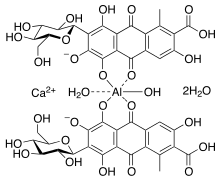
Anthraquinones (also known as anthraquinonoids) are a class of naturally occurring phenolic compounds based on the 9,10-anthraquinone skeleton. They are widely used industrially and occur naturally.
Occurrence in plants
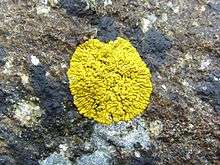 The yellow color of certain lichens (here Caloplaca thallincola) is due to the presence of anthraquinones.
The yellow color of certain lichens (here Caloplaca thallincola) is due to the presence of anthraquinones.
Natural pigments that are derivatives of anthraquinone are found, inter alia, in aloe latex, senna, rhubarb, and cascara buckthorn, fungi, lichens, and some insects. A type II polyketide synthase is responsible for anthraquinone biosynthesis in the bacterium Photorhabdus luminescens.[1] Chorismate, formed by isochorismate synthase in the shikimate pathway, is a precursor of anthraquinones in Morinda citrifolia.[2] Tests for anthraquinones in natural extracts have been established.[3]
- Senna glycosides from the senna.
- Frangulin in Frangula alnus.
- Aloe-emodin in aloe resin.
- Carmine, a bright-red pigment derived from insects.[4]
- Hypericin and fagopyrin are naphthodianthrones, anthraquinone-derivatives.
Applications
In the production of hydrogen peroxide
A large industrial application of anthraquinones is for the production of hydrogen peroxide. 2-Ethyl-9,10-anthraquinone or a related alkyl derivative is used, rather than anthraquinone itself.[5]
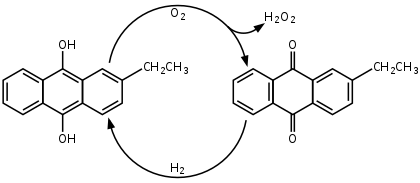
Millions of tons of hydrogen peroxide are manufactured by the anthraquinone process.[6]
Pulping
Sodium 2-anthraquinonesulfonate (AMS) is a water-soluble anthraquinone derivative that was the first anthraquinone derivative discovered to have a catalytic effect in the alkaline pulping processes.[7]
Dyestuff precursor
The 9,10-anthraquinone skeleton occurs in many dyes, such as alizarin.[8] Important derivatives of 9,10-anthraquinone are 1-nitroanthraquinone, anthraquinone-1-sulfonic acid, and the dinitroanthraquinone.[9]

Medicine
Derivatives of 9,10-anthraquinone include many important drugs (collectively called anthracenediones). They include
- Laxatives such as dantron, emodin, and aloe emodin, and some of the senna glycosides
- Antimalarials such as rufigallol
- Antineoplastics used in the treatment of cancer, such as mitoxantrone, pixantrone, and the anthracyclines
- DNA dyes / nuclear counterstains such as DRAQ5, DRAQ7 and CyTRAK Orange for flow cytometry and fluorescence microscopy.
- Anthraquinone derivatives: rhein, emodin, aloe emodin, parietin (physcion), and chrysophanol extracted from Cassia occidentalis are toxic and known to cause hepatomyoencephalopathy in children.[10]
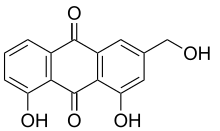 Aloe emodin
|
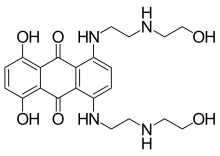 Mitoxantrone
|
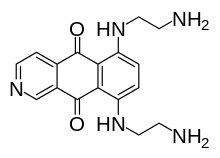 Pixantrone
|
Natural anthraquinone derivatives tend to have laxative effects. Prolonged use and abuse leads to melanosis coli.[11][12] 5 anthraquinones have been shown to inhibit the formation of Tau aggregates and dissolve paired helical filaments thought to be critical to Alzheimer's disease progression in both mouse models and in vitro testing but have not been investigated as a therapeutic agent.[13]
References
- Brachmann, AO; Joyce, SA; Jenke-Kodama, H; Schwär, G; Clarke, DJ; Bode, HB (2007). "A type II polyketide synthase is responsible for anthraquinone biosynthesis in Photorhabdus luminescens". ChemBioChem: A European Journal of Chemical Biology. 8 (14): 1721–8. doi:10.1002/cbic.200700300. PMID 17722122.
- Stalman, M; Koskamp, AM; Luderer, R; Vernooy, JH; Wind, JC; Wullems, GJ; Croes, AF (2003). "Regulation of anthraquinone biosynthesis in cell cultures of Morinda citrifolia". Journal of Plant Physiology. 160 (6): 607–14. doi:10.1078/0176-1617-00773. PMID 12872482.
- Akinjogunla OJ, Yah CS, Eghafona NO, Ogbemudia FO (2010). "Antibacterial activity of leave extracts of Nymphaea lotus (Nymphaeaceae) on Methicillin resistant Staphylococcus aureus (MRSA) and Vancomycin resistant Staphylococcus aureus (VRSA) isolated from clinical samples". Annals of Biological Research. 1 (2): 174–184.
- Dapson, R. W.; Frank, M.; Penney, D. P.; Kiernan, J. A. (2007). "Revised procedures for the certification of carmine (C.I. 75470, Natural red 4) as a biological stain". Biotechnic & Histochemistry. 82 (1): 13–15. doi:10.1080/10520290701207364. PMID 17510809.
- Goor, G.; Glenneberg, J.; Jacobi, S. (2007). "Hydrogen Peroxide". Ullmann's Encyclopedia of Industrial Chemistry. Weinheim: Wiley-VCH. doi:10.1002/14356007.a13_443.pub2. ISBN 978-3527306732.
- Campos-Martin, Jose M.; Blanco-Brieva, Gema; Fierro, Jose L. G. (2006). "Hydrogen Peroxide Synthesis: An Outlook beyond the Anthraquinone Process". Angewandte Chemie International Edition. 45 (42): 6962–6984. doi:10.1002/anie.200503779. PMID 17039551.
- "Anthraquinone / Alkali Pulping - A Literature Review" (PDF). Project 3370. Appleton, Wisconsin: The Institute of Paper Chemistry. 1978-07-05.
- Bien, H.-S.; Stawitz, J.; Wunderlich, K. (2005). "Anthraquinone Dyes and Intermediates". Ullmann's Encyclopedia of Industrial Chemistry. Weinheim: Wiley-VCH. doi:10.1002/14356007.a02_355.
- Vogel, A. "Anthraquinone". Ullmann's Encyclopedia of Industrial Chemistry. Weinheim: Wiley-VCH. doi:10.1002/14356007.a02_347.
- Panigrahi, G.K.; Suthar, M.K.; Verma, N.; Asthana, S.; Tripathi, A.; Gupta, S.K.; Saxena, J. K.; Raisuddin, S.; Das, M. (2015). "Investigation of the interaction of anthraquinones of Cassia occidentalis seeds with bovine serum albumin by molecular docking and spectroscopic analysis: Correlation to their in vitro cytotoxic potential". Food Research International. 77: 368–377. doi:10.1016/j.foodres.2015.08.022.
- Müller-Lissner, S. A. (1993). "Adverse Effects of Laxatives: Fact and Fiction". Pharmacology. 47 (Suppl 1): 138–145. doi:10.1159/000139853. PMID 8234421.
- Moriarty, K. J.; Silk, D. B. (1988). "Laxative Abuse". Digestive Diseases. 6 (1): 15–29. doi:10.1159/000171181. PMID 3280173.
- Pickhardt, M.; Gazova, Z.; von Bergen, M.; Khlistunova, I.; Wang, Y.; Hascher, A.; Mandelkow, E. M.; Biernat, J.; Mandelkow, E. (2005). "Anthraquinones Inhibit Tau Aggregation and Dissolve Alzheimer's Paired Helical Filaments in vitro and in Cells" (PDF). The Journal of Biological Chemistry. 280 (5): 3628–3635. doi:10.1074/jbc.M410984200. PMID 15525637.